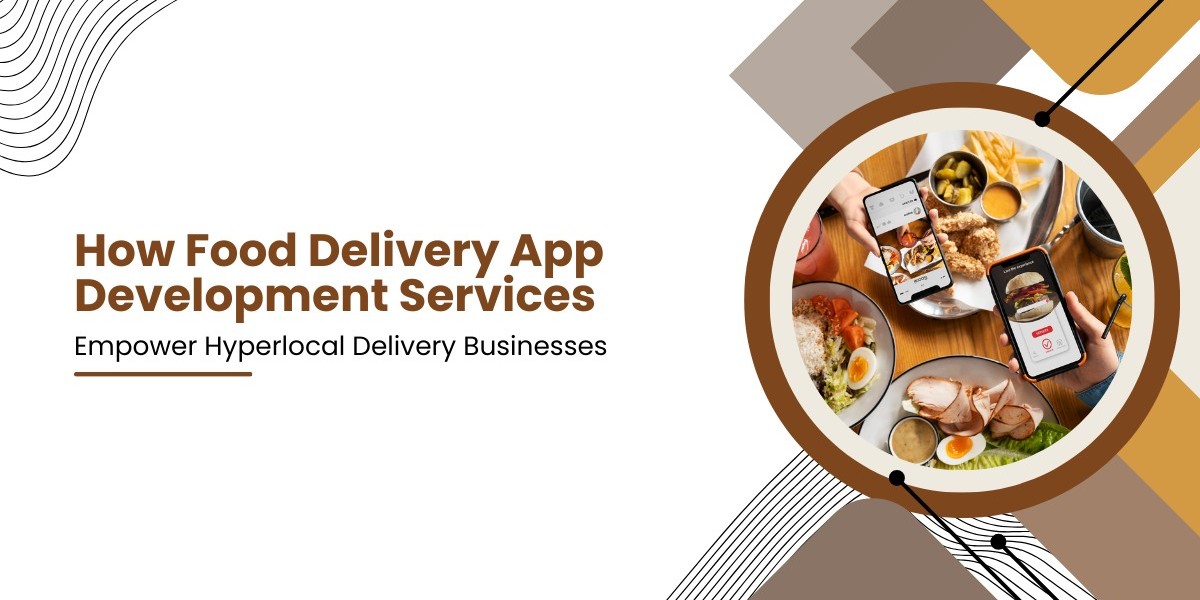In 2024, the global food delivery industry generated around $260 billion in revenue. Over 70% of orders came from hyperlocal models, with 30-minute delivery standards becoming the norm. These systems demand advanced logistics, precise mapping, and high scalability. A Food Delivery App Development Company uses robust architecture, real-time features, and analytics to power these models. In this article, we review the technical layers, key components, and future directions that enable hyperlocal delivery success.
Defining Hyperlocal Delivery
Hyperlocal delivery focuses on serving customers within a short radius typically 1–5 kilometers emphasizing speed, freshness, and convenience. This model suits groceries, meals, pharmacy items, and retail goods. It requires a combination of fast logistics, live tracking, micro-fulfillment, and dynamic pricing. Teams develop apps, dashboards, and services in parallel to drive real-time operations and user experience.
A food delivery app development services provider must implement:
High-precision geolocation and geofencing
Scalable routing and dispatch systems
Multimodal payment and dynamic billing
Near real-time analytics for optimization
Let’s unpack how each of these components fits technically.
Location and Dispatch Mechanics
1. Real-Time Geolocation
Modern apps rely on GPS tracking and cell-tower triangulation to locate drivers and users with sub-50-meter accuracy. These coordinates are transmitted every few seconds using low-latency channels to the backend. Providers cache location data in Redis to support thousands of concurrent deliveries per square kilometer.
2. Smart Dispatch and Routing
A scalable system ingests incoming orders and assigns them to drivers based on proximity, ETA, current load, and historical performance. Third-party APIs like Google Maps or Mapbox generate distance and ETA matrices. Custom heuristics then optimize for traffic variance, delivery window, and restaurant proximity.
Dispatch response times fall under 90 seconds in mature systems. Orders typically enter the system and receive a driver assignment within 30 to 60 seconds. Constant route re-calculation accounts for new traffic congestion, sudden driver availability, or ad-hoc priority orders.
User Experience and Live Tracking
Hyperlocal delivery demands transparency. Customers expect up-to-minute updates. Apps display driver movement on maps, and ETA refreshes even if the driver stops or routes adapt.
A robust Food Delivery App Development Company integrates tracking UIs with optimized packet delivery. They handle dropouts and automatically re-fetch when devices go offline. Multiple push notifications and SMS cues mark each delivery stage preparation, pickup, en route, arrived, and delivered.
Delivery partners receive real-time navigation, load details, delivery instructions, and dynamic re-routing if pickups change. These features vastly reduce delivery failures and customer complaints.
Microservices and Event-Driven Architecture
Hyperlocal systems demand resilient, scalable, and flexible backend architecture. API endpoints fall into modular microservices order, driver, routing, payment, notification, inventory, etc. Each service runs in containers and can scale independently. This architecture guarantees that delivery surges don’t overload unrelated systems.
Micro-Fulfillment Deployment
To hit sub-30-minute delivery windows, companies deploy micro-fulfillment centers and dark stores near delivery zones. Backend systems ingest real-time inventory from these micro-stores. Apps only show available stock within a user’s zone. This availability-validation step reduces failed orders by around 30% in high-density zones. Fulfillment center APIs update microservices continually, so inventory accuracy averages near 98%.
Also Read: Food Delivery Apps in Hospitality: Enhancing Guest Experience Digitally
Data Analytics, Modelling, and Learning
Analytics influence delivery strategy, pricing, and forecasting.
1. Dispatch & Route Analysis
Teams monitor average route distance, idle time, route deviation, and driver cancellation rates. These metrics feed optimization loops. For instance, data can trigger driver redeployment during expected lunch peaks, reducing idle time by up to 20%.
2. Demand Forecasting
Time-series models predict demand based on day, locality, weather, and events. Pre-staging drivers in high-traffic zones based on these models results in 15% lower average delivery time and 12% higher completion success.
3. Price Elasticity and Incentive Tuning
Hyperlocal delivery systems use peak surcharges and surge pricing. A/B-tested fare multipliers reveal how responsive users are to price at given times and distances. Proper tuning leads to optimized delivery profitability while maintaining order volume.
4. Customer Behavior Insights
Analysis extends to order patterns, repeat rates, churn signals, cart abandonment, and average basket size. Alert systems notify marketing teams to trigger retention campaigns or promotions based on user-specific clauses.
Scalability and Performance
Cloud infrastructure supports high traffic, especially during mealtime.
1. Auto-Scaling
Services scale horizontally with Kubernetes or serverless functions. CPU and request queue thresholds trigger scaling events. Throughput can exceed 10,000 API calls per second during peak hours.
2. Caching & CDNs
Time-sensitive data like menus, images, and zone definitions serve via edge caches (CloudFront, Fastly). Redis or Memcached manage session and location data to lower load on relational databases.
3. High Availability
Multi-AZ and cross-region deployments ensure 99.99% uptime. Databases use replication and read-replicas. Backups, failover, and disaster recovery are automated.
4. Load Testing
Loads mimic millions of users during sales events. Systems often model large traffic peaks with tools like Locust, JMeter, or K6 to identify bottlenecks and measure response under duress.
Security and Transaction Integrity
1. Authentication & Authorization
JWT tokens and OAuth2 protocols authenticate users. Drivers register with multi-factor checks. Session timeouts protect resilience. Admin dashboards layer RBAC for fine-grained access.
2. Compliance & Encryption
Transport layer TLS and at-rest AES-256 encryption secure user and transaction data. Compliance with local laws ensures data privacy and protects consumer rights.
In many regions, apps require license checks, health verifications, and business documents for restaurant partners. Onboarding workflows often include photo scanning, background validation, and approvals.
3. Fraud Prevention
Detection logic flags repeat chargebacks, high-value orders, or ZIP/meals mismatches. Real-time scoring systems intercept suspicious orders before fulfillment.
Technical Implementation by a Food Delivery App Development Company
A capable Food Delivery App Development Company offers service across multiple phases:
Requirements review and planning
System design with microservices and event-driven flows
Mobile apps for customers and drivers
Admin and restaurant partner dashboards
Integration with maps, routing, and SMS gateways
Payment gateway and dynamic pricing engine
Inventory APIs for micro-centers
CI/CD pipelines, infrastructure, and load testing
QA automation and field testing
Real-time analytics dashboards
Production monitoring, logging, and alerting
Regular upgrades, feature enhancements, and scaling
As a result, businesses can launch and mature their hyperlocal capabilities swiftly.
Case Studies
1. Swiggy (India)
Swiggy operates local kitchens and micro-hubs. It processes 80% of deliveries within 30 minutes at lunch peaks. The company uses geofencing and predictive staging to match drivers. It optimizes menu visibility based on hub stock. These tactics reduced delivery drops by 27%.
2. Deliveroo (UK)
Deliveroo uses machine learning to forecast user demand and stage riders accordingly. Rider utilization increased by 30% while delivery time dropped 15% post-implementation.
3. Instacart (US)
Instacart's micro-fulfillment centers are placed inside grocery stores or shipping containers. This setup cuts delivery time by an estimated 40% in dense urban areas.
Challenges and Solutions
1. Traffic Congestion
Adaptive route recalculation with live data and avoidance buffers reduces delays. This method improves less predictable urban rides by 5–10%.
2. Inventory Drift
Companies assign temporary stock reservations at cart time. Timed cleanup tasks release unfulfilled slots to avoid deadlocks.
3. Peak Demand Spikes
Autoscaling and queue buffers prevent system overload during flash-sales or meal-time surges.
4. Region-Specific Compliance
Integration of document workflows supports license, health card, and legal onboarding for restaurants. Admin tools help manage expired documentation.
Emerging Enhancements
Drone & AV Delivery
Pilot programs often use drones and autonomous vehicles for last-mile delivery. This requires drone APIs, geofencing around no-fly zones, and route simulation.
EV Routing
Routing engines are EV-aware they factor in charge station locations, battery performance, and range forecasting. This feature limits deliveries to sustainable drivers on electric bicycles or scooters.
Augmented Reality
AR view helps drivers locate apartment buildings, apartment numbers, or parking areas. Customers can use augmented prompts to guide couriers.
Predictive Stock Placement
Based on usage patterns, the system automatically recommends placing specific SKUs in certain micro-centres ahead of high demand zones.
Measuring Success
To track effectiveness, companies monitor both operational and business metrics.
Technical metrics:
Average delivery time
Dispatch latency (order to assignment)
ETA accuracy within 2 minutes
System uptime
Scaling response time
Business metrics:
Repeat orders per user
Basket size
Cart abandonment rate
Revenue per delivery
Cost to fulfill
Graphs and dashboards support continuous improvement. QA teams and dev groups analyze when thresholds exceed defined SLAs.
Conclusion
Hyperlocal delivery demands a complex ecosystem stitched together by a robust technical framework. A Food Delivery App Development Company brings this ecosystem to life by combining real-time logistics, scalable architecture, microservices, and analytics. Mobile clients, admin panels, and driver tools work together to deliver within 30 minutes while maintaining reliability and integrity.
Technology plays a central role from stepwise dispatch liveness, through inventory sync, to user retention dashboards. Tools and patterns like Redis-backed pub/sub, multi-AZ services, JWT authentication, EV-aware routing, and drone integration future-proof these systems. Governance mechanisms help manage risk while maintaining agility.








